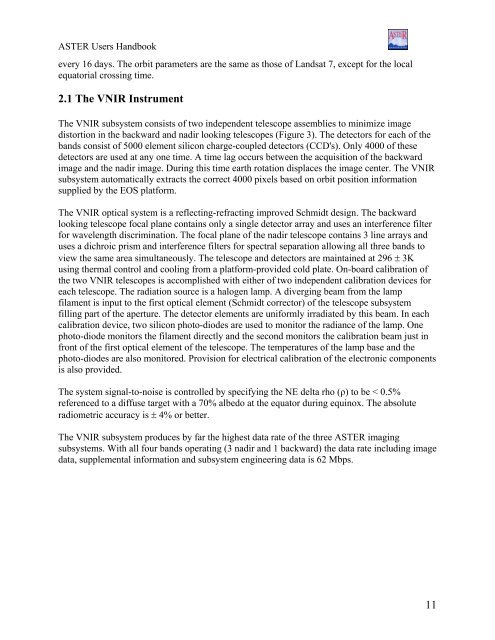Create successful ePaper yourself
Turn your PDF publications into a flip-book with our unique Google optimized e-Paper software.
<strong>ASTER</strong> Users Handbookevery 16 days. The orbit parameters are the same as those of Landsat 7, except for the localequatorial crossing time.2.1 The VNIR InstrumentThe VNIR subsystem consists of two independent telescope assemblies to minimize imagedistortion in the backward and nadir looking telescopes (Figure 3). The detectors for each of thebands consist of 5000 element silicon charge-coupled detectors (CCD's). Only 4000 of thesedetectors are used at any one time. A time lag occurs between the acquisition of the backwardimage and the nadir image. During this time earth rotation displaces the image center. The VNIRsubsystem automatically extracts the correct 4000 pixels based on orbit position informationsupplied by the EOS platform.The VNIR optical system is a reflecting-refracting improved Schmidt design. The backwardlooking telescope focal plane contains only a single detector array and uses an interference filterfor wavelength discrimination. The focal plane of the nadir telescope contains 3 line arrays anduses a dichroic prism and interference filters for spectral separation allowing all three bands toview the same area simultaneously. The telescope and detectors are maintained at 296 ± 3Kusing thermal control and cooling from a platform-provided cold plate. On-board calibration ofthe two VNIR telescopes is accomplished with either of two independent calibration devices foreach telescope. The radiation source is a halogen lamp. A diverging beam from the lampfilament is input to the first optical element (Schmidt corrector) of the telescope subsystemfilling part of the aperture. The detector elements are uniformly irradiated by this beam. In eachcalibration device, two silicon photo-diodes are used to monitor the radiance of the lamp. Onephoto-diode monitors the filament directly and the second monitors the calibration beam just infront of the first optical element of the telescope. The temperatures of the lamp base and thephoto-diodes are also monitored. Provision for electrical calibration of the electronic componentsis also provided.The system signal-to-noise is controlled by specifying the NE delta rho (ρ) to be < 0.5%referenced to a diffuse target with a 70% albedo at the equator during equinox. The absoluteradiometric accuracy is ± 4% or better.The VNIR subsystem produces by far the highest data rate of the three <strong>ASTER</strong> imagingsubsystems. With all four bands operating (3 nadir and 1 backward) the data rate including imagedata, supplemental information and subsystem engineering data is 62 Mbps.11















